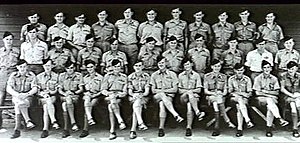No. 6 Service Flying Training School RAAF
| No. 6 Service Flying Training School RAAF | |
|---|---|

Trainees of No. 6 Service Flying Training School, c. 1944
|
|
| Active | 1941–1946 |
| Allegiance | Australia |
| Branch | Royal Australian Air Force |
| Role | Intermediate/advanced flying training |
| Part of | No. 1 Training Group |
| Garrison/HQ | RAAF Station Mallala |
No. 6 Service Flying Training School (No. 6 SFTS) was a flying training school of the Royal Australian Air Force (RAAF) during World War II. It was formed in August 1941, and commenced flying the following month. Responsible for intermediate and advanced instruction of pilots under the Empire Air Training Scheme (EATS), the school was based at RAAF Station Mallala, South Australia, and operated Avro Anson and Airspeed Oxford aircraft. The school formed a reserve squadron for Australia's defence after the outbreak of war in the Pacific in December 1941. Having graduated over 2,000 pilots, No. 6 SFTS completed its final training course in September 1945, and was re-formed as Care and Maintenance Unit Mallala in January 1946.
RAAF aircrew training expanded dramatically following the outbreak of World War II, in response to Australia's participation in the Empire Air Training Scheme (EATS). The Air Force's pre-war flight training facility, No. 1 Flying Training School at RAAF Station Point Cook, Victoria, was supplanted in 1940–41 by twelve Elementary Flying Training Schools (EFTS), eight Service Flying Training Schools (SFTS), and Central Flying School (CFS). While CFS turned out new flight instructors, the EFTS provided basic training to prospective pilots who, if successful, would go on to an SFTS for further instruction that focussed on operational (or "service") flying. The course at SFTS typically consisted of two streams, intermediate and advanced, and included such techniques as instrument flying, night flying, advanced aerobatics, formation flying, dive bombing, and aerial gunnery. The total duration of training varied during the war as demand for aircrew rose and fell. Initially running for 16 weeks, the course was cut to 10 weeks (which included 75 hours flying time) in October 1940. A year later it was raised to 12 weeks (including 100 hours flying time), and again to 16 weeks two months later. It continued to increase after this, peaking at 28 weeks in June 1944.
...
Wikipedia
